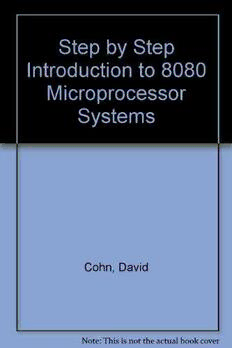Table Of ContentA Step By Step
8080
IntroductionTo
Microprocessor Systems
David L.Cohn and James L. Melsa
A/C
A Step By Step Introduction
To 8080 Microprocessor Systems
6
A Step By Step
8080
IntroduclionTo
Microprocessor Systems
David LCohn and James L. Melsa
Department of Electrical Engineering
Universityof Notre Dame
dilithium
PRESS P.O. Box92 ForestGrove,Oregon9711
AStepByStepIntroductionTo8080MicroprocessorSystems
DavidL.Conn
JamesL.Melsa
DepartmentofElectrical Engineering
UniversityofNotreDame
ISBN0-918398-04-5
© Copyright 1977bydilithiumPress
P.O.Box92,ForestGrove,Oregon97116
LibraryofCongressCatalogingin PublicationData
Cohn,DavidL 1943-
Astepbystepintroductionto8080microprocessor
systems.
1.INTEL8080(Computer)2.Microprocessors.
I.Melsa,JamesL.,jointauthor.II.Title.
QA76.8.I28C63 001.6'4'04 77-21762
ISBN0-918398-04-5
PrintedInTheUnitedStatesofAmerica
Toourown eight bits:
Alan
Elisabeth
Jennifer
Jon
Laina
Mark
Peter
Susan
CONTENTS
Preface
1. Introduction 1
1.1 Historical Perspectives
1.2 TypicalApplications
1.3 OutlineoftheBook
2. BasicMachineStructure 5
2.1 Bitsand Bytes
2.2 SystemStructure
2.3 InstructionConceptsand Instruction Decoder
2.4 SampleProgram
2.5 RotateandComplement Instructions
2.6 Exercises
3. MoreMachineStructure 15
3.1 IntroductionofAdditional Registers
3.2 MOVeinstructions
3.3 LogicInstructions
3.4 Exercises
4. StoredPrograms 23
4.1 Hexadecimal,Octaland BinaryNumbers
4.2 ImmediateInstructions
4.3 UseofMemoryforProgramStorage
4.4 Entering ProgramsintoMemory
4.5 TypesofMemory
4.6 Arithmetic Instructions
4.7 Exercises
5. JumpInstructions 35
5.1 PageStructureofMemory
5.2 UnconditionalJumps
5.3 ConditionalJumps
5.4 Input Directed Programs
5.5 Exercises
6. UseofMemoryforDataStorage 41
6.1 DirectAddressing
6.2 UseofHLRegisterPair
6.3 ExampleoftheUseofMemory
6.4 Exercises
viii AStep ByStepIntroductionTo8080MicroprocessorSystems
7. System Monitors 49
7.1 StartingtheMonitor
7.2 DisplayingandChanging Memory
7.3 TransferingControl
7.4 Displaying Registers
7.5 Breakpoints
7.6 OtherMonitorCommands
7.7 Exercises
8. UseofTerminalforInputandOutput 59
8.1 ASCII Code
8.2 Inputfromthe Keyboard
8.3 Outputtothe Printer
8.4 PaperTapeReaderand Punch
8.5 Exercises
9. Editors 69
9.1 SymbolicAssemblersand Editors
9.2 Basic Features
9.3 TheINTELEditor
9.4 Example
9.5 CharacterManipulations
9.6 Exercises
10. SymbolicAssemblers 81
10.1 Instruction Format
10.2 Location Namesand Instruction Mnemonics
10.3 Pseudo-Operationsand Data
10.4 OperationofanAssembler
10.5 Example
10.6 Exercises
11. StacksandSubroutines 91
11.1 StackandStackOperations
11.2 CALLand RETurn Instructions
11.3 Example
11.4 Exercises
12. MicrocomputerArchitecture 101
12.1 DeviceDecoder
12.2 LatchedOutput
12.3 Input Ports
12.4 Example
12.5 Exercises
Contents ix
13. InterfaceDevices 109
13.1 Light-Emitting Diodes
13.2 Segment Displays
13.3 LiquidCrystal Displays
13.4 RelaysandStep Motors
13.5 Thumbwheels
13.6 A/Dand D/AConverters
13.7 Exercises
14. InterruptsandReal-timeClocks 117
14.1 PollingversusInterrupts
14.2 Programmingwith Interrupts
14.3 Timers
14.4 Example
14.5 Exercises
15. PeripheralEquipment 123
15.1 CassetteTape
15.2 FloppyDisk
15.3 LinePrinter
15.4 ModemandUART
15.5 Exercises
16. ComparisonofVariousProcessors 129
16.1 Four-bitProcessors
16.2 The8085
16.3 TheZ80
16.4 The6800
16.5 TheF8
16.6 The8048
16.7 OtherEight-bit Processors
16.8 Sixteen-bit Processors
17. OtherApproachestoProgramming 137
17.1 CrossAssemblersandTimeSharing
PUM
17.2
17.3 BASIC
A. AlphabeticalListingofInstructions 143
B. 8080InstructionListingbyFunction 157
C. ASCIICodeTable 161
INDEX 167
AStepByStep IntroductionTo8080MicroprocessorSystems
PREFACE
This microprocessor book is written for people who don't
know anything about microprocessors but who wish they
did. The step-by-step presentation does not require any
computer or electronics background; so anyone who is
interested can follow it. However, the book is not only
intended for beginners. Engineers and technicians who are
familiar with electronics will find the software descriptions
valuable in updating their skills. Computer professionals
will find the detailed treatment of the 8080 architecture and
instruction set useful.
The best wayto learn about any type of computer is to sit
down and use it. For those readers lucky enough to have
access to an 8080 system, the book contains a number of
exercises which illustrate the concepts discussed in each
chapter. If at all possible, these exercises should be done
whilethe book is being read.
Ofcourse, many readerswill not havean 8080-based com-
puter. Indeed, they may be trying to decide if they should
buy such a system. Therefore, many of the exercises have
been designed to beworked out with pencil and paper. Ifthe
easy exercises at the front of the book are done carefully,
the material laterin the bookwill also beeasy.
In order to present a clear picture of microprocessors,
this bookfocuses on one particulartypeof device, the8080.
By concentrating on the 8080, the details of microprocessor
structure can be examined. When the reader fully under-
stands the 8080, he will be amazed at how easy it is to
understand other types of microprocessors. The same
approach is used when describing system programs. These
programs are very useful for writing and fixing other pro-

